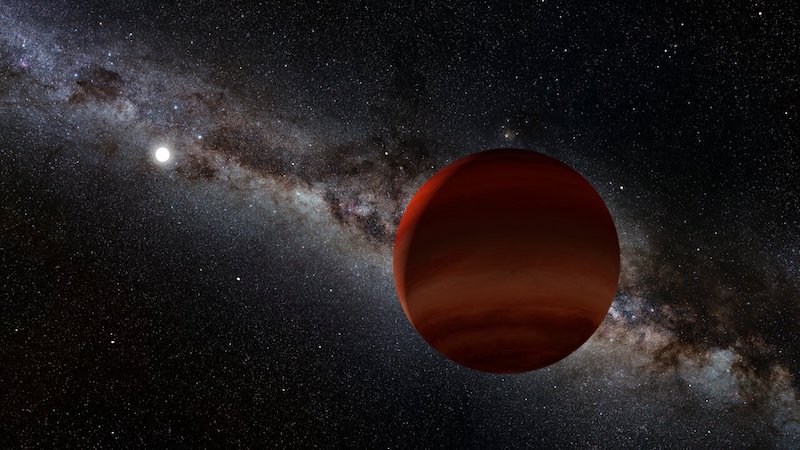
Brown dwarfs are too massive to be planets. And they’re not massive enough to spark thermonuclear reactions in their cores. That means they can’t shine as stars do. So brown dwarfs are sometimes called failed stars. And they’re typically cool in contrast to stars. They’re typically cooler than our sun. But this month (August 2023), astronomers reported a new hot Jupiter-like brown dwarf, the hottest found so far. Weirdly, this failed star is hotter than our sun.
Scientists at the Weizmann Institute of Science in Israel reported the discovery on August 14, 2023.
But why is it so hot? The scientists explored the reason in a new paper, published in the peer-reviewed journal Nature Astronomy on August 14, 2023. A free preprint is also available on arXiv.
Why is the brown dwarf hot?
The brown dwarf orbits a white dwarf star. The white dwarf is called WD 0032–317. This odd double system – only the 13th brown dwarf/white dwarf binary discovered so far – is located some 1,400 light-years from Earth.
The secret to the brown dwarf being so hot is that it orbits closely with the white dwarf.
It orbits closely enough to be tidally locked with the white dwarf, much as our moon is tidally locked to Earth. In other words, one side of the brown dwarf always faces the white dwarf star.
So the brown dwarf has a permanent day side and night side. And that fact is the key to its high surface temperatures. The day side of the brown dwarf has an estimated temperature ranging from 7,250 to 9,800 Kelvin (6,900 to 9,500 Celsius). That makes it as hot as an A-type star. It’s also about 2,000 degrees hotter than the surface of our sun.
By contrast, the temperature of the night side is significantly lower, from 1,300 to 3,000 K (1,000 to 2,700 C).
A perfect laboratory
Na’ama Hallakoun at the Weizmann Institute of Science is the lead author of the new paper. She said:
We’ve identified a star-orbiting hot Jupiter-like object that is the hottest ever found, about 2,000 degrees hotter than the surface of the sun.
Most hot Jupiters are difficult to study because they’re obscured by the glare of their stars. But this one is easier because it’s quite large compared to its host star, and the star itself is 10,000 times fainter than usual. Hallakoun said:
This makes it a perfect laboratory for future studies of hot Jupiters’ extreme conditions.
An unusual binary system
Interestingly, both objects in this binary system are called dwarfs. But they are very different types of objects.
A white dwarf is technically a star. It’s an evolved star, what remains of a former sunlike star. A white dwarf star has depleted of its nuclear fuel, so it can no longer shine as our sun and other stars do. It’s essentially the hot, white core of a star.
If a planet, or brown dwarf, for example, gets too close to its star, the star’s gravity can rip it apart. In this case, however, the brown dwarf is too dense to be ripped apart. Hallakoun stated:
Stars’ gravity can cause objects that get too close to break apart. But this brown dwarf is dense, with 80 times the mass of Jupiter squeezed into the size of Jupiter. This allows it to survive intact and form a stable, binary system.

Clues about planetary atmospheres
This newly discovered brown dwarf provides a unique opportunity to learn more about planetary atmospheres, researchers say. Specifically, it provides insight into the effects of extreme ultraviolet radiation. In this case, the radiation is coming to the brown dwarf from the white dwarf star. The radiation can cause the gas that composes the brown dwarf to evaporate. It can break the molecules making up the brown dwarf apart. As Hallakoun explained:
Merely one million years since the formation of the white dwarf in this system – a minuscule amount of a time on the astronomical scale – we have gotten a rare glimpse into the early days of this kind of compact binary system.
Hot Jupiters are the antithesis of habitable planets; they are dramatically inhospitable places for life. Future high-resolution spectroscopic observations of this hot Jupiter-like system – ideally made with NASA’s new James Webb Space Telescope – may reveal how hot, highly irradiated conditions impact atmospheric structure, something that could help us understand exoplanets elsewhere in the universe.
The results will help scientists better understand the similarities and differences between exotic worlds like brown dwarfs and hot Jupiters. Both are unlike any planets or other bodies in our own solar system, making them exciting objects of study for astronomers.
Bottom line: Astronomers have discovered a brown dwarf that is similar to a hot Jupiter exoplanet. It is hotter than any hot Jupiter seen before, even hotter than our sun.
Source: An irradiated-Jupiter analogue hotter than the sun
Source (preprint): An irradiated-Jupiter analogue hotter than the sun
Via Weizmann Institute of Science
Read more: What are brown dwarfs?
Read more: The unexpected, exotic characteristics of hot Jupiters











